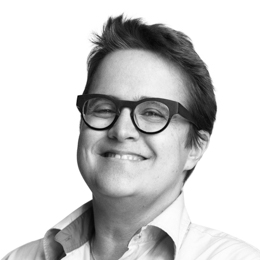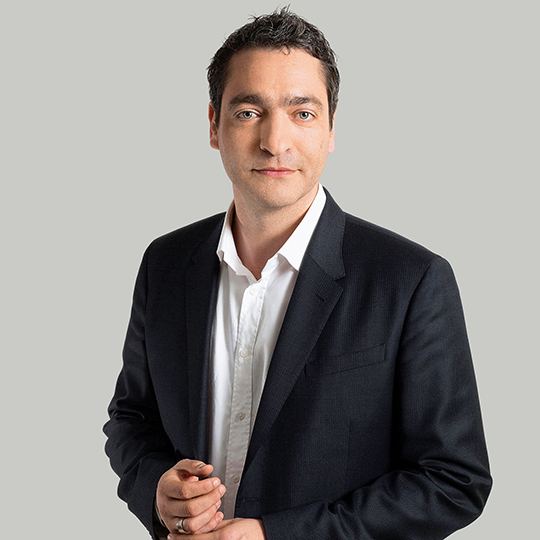How is Nanobiotix's approach different?
Laurent Lévy: We were among the first to explore nanotechnologies and see how we could use their extraordinary potential in medicine. In doing so, we adopted an approach that was novel at the time, bringing together biologists, chemists and physicians.
We take a physical approach to the human body and the way it works, and the physical way in which our nanoparticles work means that we are entirely or partly free of the constraints arising from the biological variability of patients. We are therefore going against the tide of personalised medicine, aiming to offer excellent and precise solutions that can potentially be used by millions of patients.
How does your innovation work in practical terms?
L.L.: We have developed a product intended to make radiotherapy more effective when treating tumours, without increasing the dose received by the surrounding healthy tissue. In practical terms, the day before the patient has his/her first session of traditional radiotherapy, hafnium nanoparticles - designed by us - are injected directly, and once only, into the cancerous cells.
Once injected into the heart of the tumour, they penetrate the cells, where they absorb the rays delivered by radiotherapy and thus magnify and amplify their local effect.
What were your various phases of development?
L.L.: After looking at various approaches, we decided to focus our technology on this combination of radiotherapy and nanoparticles. After traditional animal-based preclinical experiments, clinical trials began in 2011 and our nanoparticles were injected into our first patient. Roughly speaking, the various clinical trials are aimed at assessing general safety (non-toxicity, tolerability etc.) and the feasibility of using the product, determining the correct dose, and then assessing the product's efficacy and comparing it with standard treatments. We published our first clinical trial results in 2014 relating to soft tissue sarcomas, and we are hoping to obtain CE marking for our NBTXR3 product in 2017. Subsequently, we obtained results for head and neck cancers and liver cancers. We are also carrying out clinical trials for prostate and rectal cancer. The product is currently being assessed in a total of seven indications, in the USA, Europe and Asia, in trials involving 400 doctors in 54 referral centres.
Are further innovations in the works?
L.L.: Eventually, we want to see our product used alongside radiotherapy in all situations, which would potentially broaden its application to all solid tumours. Aside from the seven oncology indications we are currently working on, we could in the future address breast cancer and glioblastoma (a kind of brain tumour). Also, and again with NBTXR3, we are working on an immuno-oncology programme that has already delivered some very encouraging preclinical results.
What is your relationship with Crédit Mutuel Innovation?
L.L.: Crédit Mutuel Innovation (formerly CM-CIC Innovation) bought into Nanobiotix in our third funding round, so fairly early on in our development. It was one of the long-term investors represented on our board of directors until we floated in 2012. It has been involved in our strategic discussions for many years, and is one of the partners that have played a key role in building Nanobiotix's future.
What the partner says

Everyone agrees that nanotechnology and nanoparticles are opening up many exciting possibilities. Nanobiotix should help people understand the potential of these technologies.
The company's solutions increase the effectiveness of radiotherapy, which is used to treat most cancers but causes side-effects for the healthy tissue surrounding the tumour. We took the view that the ability to make radiotherapy more effective, and only within the tumours themselves, was of major interest for patients but also in terms of health economics. That was back in 2008, when clinical trials were still a long way off for the company.
The solution works in a physical, not biological, manner, and so there seemed to be little chance that it would be restricted to only part of the population.
Nanobiotix's team was able to develop a platform allowing it to work on several nanoparticles and several delivery methods. Next, it has been able to conduct preclinical and clinical trials and comply with all related regulatory requirements, while continuing to develop its projects, as shown by its recent highly promising results in the field of immuno-oncology.
At the same time, Laurent Lévy and his team have been able to sign partnerships in Asia, to attract equity investors - firstly in France and then abroad - and to establish the company in the USA. The company has achieved all that partly by recruiting high-quality staff.
We have therefore been very fortunate to be able to work with Nanobiotix as it has transformed itself from a research company into one that is developing products that are actually used on human beings and that is expanding internationally.
2003Company founded
2012Flotation
2014Creation of the US subsidiary
6 clinical trials underway,
looking at seven oncology
indications in 17 countries around the world.
€5 to 0 billion of potential sales
with the first product
in development.




